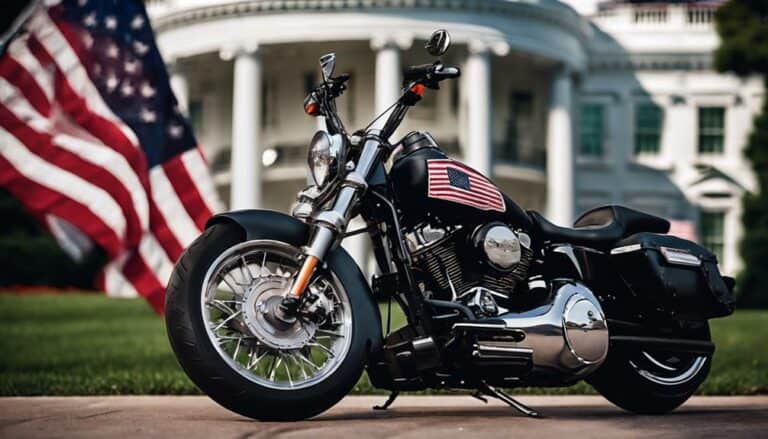You might be surprised to learn about the intricate relationship between President Trump and Harley-Davidson. Despite initial expectations, the impact of Trump's policies on the iconic motorcycle company goes beyond what meets the eye.
From trade disputes to tax cuts, the story of Harley-Davidson under the Trump administration unveils a complex web of challenges and opportunities.
Stay tuned to uncover the multifaceted dynamics at play and the implications for this legendary American brand.
Key Takeaways
- Imposed tariffs on EU, impacting Harley-Davidson's exports.
- Tax cuts created a pro-business environment benefiting Harley.
- Criticized Harley's production relocation, emphasizing American manufacturing.
- Harley focuses on growth with new models to attract a wider consumer base.
Tariffs on Steel and Aluminum
Due to Trump's decision to impose tariffs on steel and aluminum from the EU, repercussions were felt across various industries, including Harley-Davidson. Trump implemented tariffs of 25% on steel and 10% on aluminum imported from Europe.
In response to these tariffs, the EU retaliated by significantly increasing tariffs on Harley-Davidson motorcycles. The tariffs on these motorcycles surged from 6% to 31%, with plans for further escalation to 56% by 2021. This sudden spike in tariffs had a direct impact on Harley-Davidson's operations, prompting the company to make strategic decisions regarding its production processes.
In light of the trade tensions and the adverse effects on their business, Harley-Davidson opted to relocate some of its production outside of the United States. This move was a direct result of the trade dispute initiated by Trump's tariffs, illustrating the broader implications of such actions on multinational companies like Harley-Davidson.
Trade War Impact on Harley
Amid escalating trade tensions, Harley-Davidson faced significant challenges due to the impact of tariffs imposed on its motorcycles by the EU in response to Trump's trade policies. The European Union tariffs on Harleys surged from 6% to 31%, with a further increase to 56% slated for June 2021. This move would add over $2,000 to each motorcycle exported to Europe, directly affecting Harley-Davidson's financial performance. The company declared that the trade disputes and tariffs were key factors influencing its decision to shift some production outside the U.S.
Harley-Davidson faced a substantial increase in EU tariffs on its motorcycles.
The tariffs threatened to significantly raise the cost of exporting Harleys to Europe.
The company cited trade disputes and tariffs as reasons for considering moving some production overseas.
Tax Cuts and Business Environment
The Tax Cuts and Jobs Act of 2017, implemented under Trump's administration, significantly lowered the corporate tax rate from 35% to 21%, providing companies such as Harley-Davidson with enhanced financial advantages. The said tax cuts aimed to create a more pro-business environment, with the intention of stimulating economic growth and competitiveness for American businesses, including Harley-Davidson.
Lower corporate taxes translated into increased profits for the company, allowing for potential investments in innovation and expansion. Trump's policies were designed to reduce tax burdens on companies like Harley-Davidson, fostering a climate that supported growth and development. By lowering the corporate tax rate, the Trump administration sought to boost economic growth and enhance the competitiveness of American companies, aligning with the goal of creating a more favorable environment for businesses to thrive.
White House Meeting and Support
After discussing the impact of tax cuts on businesses like Harley-Davidson, the White House meeting between President Trump and Harley-Davidson executives addressed the company's decision to move some production overseas. During the meeting, Trump expressed support for American manufacturing and criticized Harley-Davidson's decision to shift production outside the U.S.
The meeting highlighted the tensions between the administration's trade policies and Harley-Davidson's business strategy. Trump's involvement in the discussions underscored the impact of trade disputes on iconic American companies like Harley-Davidson.
The White House meeting reflected the challenges faced by Harley-Davidson in balancing trade considerations with operational decisions. It showcased the intricate relationship between governmental trade policies and the operational strategies of businesses like Harley-Davidson. The discussions emphasized the complexities involved in maintaining American manufacturing roots while navigating global market dynamics and trade pressures.
Future Outlook for Harley
Looking ahead, Harley-Davidson strategically focuses on attracting a younger demographic and expanding its market through the introduction of smaller bikes and electric-powered models.
The company's decision to launch the LiveWire electric model in August 2019 demonstrates a commitment to innovation and adapting to evolving consumer preferences.
Despite challenges such as Trump's tariffs and EU tariffs impacting their production costs, Harley-Davidson remains resilient in its efforts to grow. The Trump administration's imposition of incremental tariffs led the company to move some production overseas to mitigate financial strain.
Harley's announcement to diversify its offerings aligns with the goal of building a more inclusive product line to appeal to a wider range of consumers. By exploring new markets, particularly in Asia, Harley-Davidson aims to solidify its position in the industry and secure future success amidst a changing economic landscape.
The company's proactive approach to addressing market shifts indicates a willingness to adapt and thrive in the face of challenges.
Conclusion
In conclusion, despite facing challenges due to trade disputes and tariffs, Harley-Davidson has been able to adapt and strategize by exploring new market opportunities, such as smaller bikes and electric models.
The company's future outlook remains uncertain, but with recent support from the White House and a changing business environment, there's a glimmer of hope for Harley to ride through the storm and emerge stronger than before.

